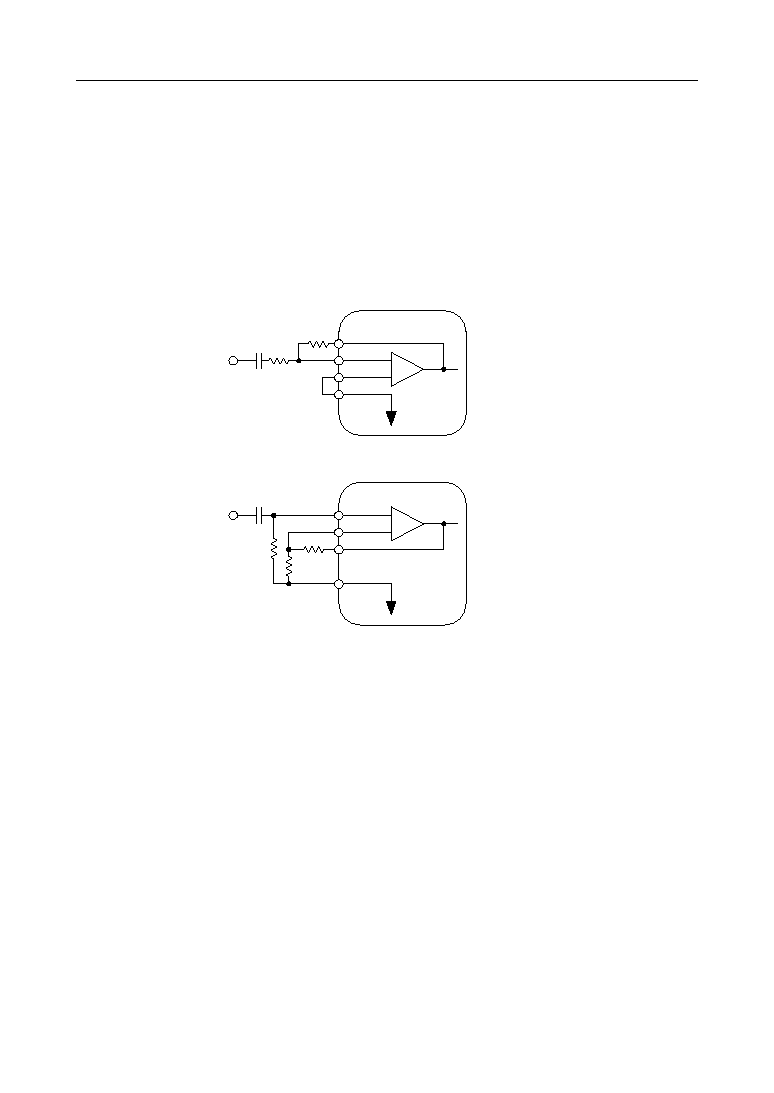
° Semiconductor
ML7000-01/02/03/ML7001-01/02/03
1/19
° Semiconductor
ML7000-01/02/03
ML7001-01/02/03
Single Rail CODEC
GENERAL DESCRIPTION
The ML7000/ML7001 are single-channel CMOS CODEC LSI devices for voice signals ranging
from 300 to 3400 Hz with filters for A/D and D/A conversion.
Designed especially for a single-power supply and low-power applications, the devices are
optimized for ISDN terminals, digital wireless systems, and digital PBXs.
The devices use the same transmission clocks as those used in the MSM7507.
With the differential analog signal outputs which can drive 60 W load, the devices can directly
drive a handset receiver.
FEATURES
∑ Single power supply: +5 V (ML7000-xx)
+3 V (ML7001-xx)
∑ Low power consumption
Operating mode:
25 mW Typ.
V
DD
= 5.0 V (ML7000-xx)
20 mW Typ.
V
DD
= 3.0 V (ML7001-xx)
Power-down mode:
0.05 mW Typ.
V
DD
= 5.0 V (ML7000-xx)
0.03 mW Typ.
V
DD
= 3.0 V (ML7001-xx)
∑ Conforms to ITU-T Companding law
ML7000-01/ML7001-01:
m/A-law pin selectable
ML7000-02/ML7001-02:
m-law
ML7000-03/ML7001-03:
A-law
∑ Transmission characteristics conform to ITU-T G.714
∑ Short frame sync timing operation
∑ Built-in PLL eliminates a master clock
∑ Serial data rate: 64/96/128/192/200/256/384/512/
768/1024/1536/1544/2048 kHz
∑ Adjustable transmit gain
∑ Adjustable receive gain
∑ Built-in reference voltage supply
∑ Package options:
24-pin plastic SOP (SOP24-P-430-1.27-K)
(Product name: ML7000-01MA/ML7001-01MA)
(Product name: ML7000-02MA/ML7001-02MA)
(Product name: ML7000-03MA/ML7001-03MA)
20-pin plastic SSOP (SSOP20-P-250-0.95-K) (Product name: ML7000-01MB/ML7001-01MB)
(Product name: ML7000-02MB/ML7001-02MB)
(Product name: ML7000-03MB/ML7001-03MB)
E2U0062-18-84
This version: Aug. 1998
Preliminary

° Semiconductor
ML7000-01/02/03/ML7001-01/02/03
2/19
BLOCK DIAGRAM
RC
LPF
8th
BPF
A/D
CONV.
TCONT
AUTO
ZERO
5th
LPF
D/A
CONV.
PWD
Logic
PLL
RTIM
RCONT
PCMOUT
PCMIN
PDN
V
DD
AG
DG
SG
GEN
SGC
SG
PWD
≠
+
AIN≠
AIN+
GSX
≠
+
VFRO
RSYNC
BCLK
XSYNC
(ALAW)
VR
GEN
≠
+
AOUT≠
PWI
≠
+
AOUT+

° Semiconductor
ML7000-01/02/03/ML7001-01/02/03
3/19
PIN CONFIGURATION (TOP VIEW)
1
2
3
4
5
6
7
8
9
10
11
12
13
14
15
16
17
18
19
20
SG
AOUT+
AOUT≠
PWI
VFRO
V
DD
DG
PDN
SGC
AIN+
AIN≠
GSX
AG
BCLK
20-Pin Plastic SSOP
RSYNC
PCMIN
XSYNC
PCMOUT
1
2
3
4
5
6
7
8
9
10
11
12
13
14
15
16
17
18
19
20
21
22
23
24
SG
AOUT+
AOUT≠
PWI
VFRO
DG
PDN
SGC
AIN+
AIN≠
GSX
AG
24-Pin Plastic SOP
RSYNC
PCMIN
XSYNC
PCMOUT
V
DD
BCLK
(ALAW)*
NC
NC
NC
(ALAW)*
NC
NC
NC
* The ALAW pin is only supported by the ML7000-01MA/ML7000-01MB/ML7001-01MA/
ML7001-01MB.
NC : No connect pin

° Semiconductor
ML7000-01/02/03/ML7001-01/02/03
4/19
PIN FUNCTIONAL DESCRIPTION
AIN+, AIN≠, GSX
Transmit analog input and transmit level adjustment.
AIN+ is a non-inverting input to the op-amp; AIN≠ is an inverting input to the op-amp; GSX is
connected to the output of the op-amp.
The level adjustment should be performed using any of the methods shown below. During
power-saving and power-down modes, the GSX output is at AG voltage.
AG
Analog ground.
VFRO
Receive filter output.
The output signal has an amplitude of 2.4 V
PP
for ML7000-xx and 2.0 V
PP
for ML7001-xx above
and below the signal ground voltage (SG) when the digital signal of +3 dBm0 is input to PCMIN
and can drive a load of 20 kW or more.
For driving a load of less than 20 kW, connect a resistor of 20 kW or more between the pins VFRO
and PWI.
During power-saving or power-down mode, the VFRO output is at an SG level.
When adjusting the receive signal on the basis of frequency characteristics, refer to the Frequency
Characteristics Adjustment Circuit.
≠
+
AIN≠
AIN+
C1
Analog input
R1 : variable
R2 > 20 kW
C1 > 1/(2 • 3.14 • 30 • R1)
R2
GSX
SG
+
≠
AIN+
AIN≠
R3 > 20 kW
R4 > 20 kW
R5 > 50 kW
C2 > 1/ (2 • 3.14 • 30 • R5)
R4
GSX
SG
C2
Analog input
R3
R5
R1

° Semiconductor
ML7000-01/02/03/ML7001-01/02/03
5/19
PWI, AOUT+, AOUT≠
PWI is connected to the inverting input of the receive driver.
The receive driver output is connected to the AOUT≠ pin. Therefore, the receive level can be
adjusted with the pins VFRO, PWI, and AOUT≠. During power-saving or power down-mode,
the outputs of AOUT+ and AOUT≠ are in a high impedance state. The output of AOUT+ is
inverted with respect to the output of AOUT≠. Since these outputs provide differential drive of
an impedance of 1.2 kW, they can directly be connected to a handset using a piezoelectric
earphone or a line transformer. Refer to the application example.
V
DD
Power supply for +5 V (ML7000-xx) or +3 V (ML7001-xx)
PCMIN
PCM data input.
A serial PCM data input to this pin is converted to an analog signal in synchronization with the
RSYNC signal and BCLK signal.
The data rate of PCM is equal to the frequency of the BCLK signal.
PCM signal is shifted in at the falling edge of the BCLK signal and latched into the internal
register when shifted by eight bits.
The start of the PCM data (MSD) is identified at the rising edge of RSYNC.
BCLK
Shift clock signal input for the PCMIN and PCMOUT signals.
The frequency, equal to the data rate, is 64, 96, 128, 192, 256, 384, 512, 768, 1024, 1536, 1544, or 2048
kHz. Setting this signal to logic "1" or "0" drives both transmit and receive circuits to the power
saving state.
R6 > 20 kW
ZL > 1.2 kW
Gain = VO/VI = 2 5 R7/R6 £ 2
R6
R7
≠
+
SG
≠
+
SG
VFRO
PWI
AOUT≠
AOUT+
ZL
Receive filter
VI
VO
20 kW
20 kW




